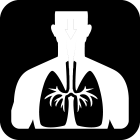 Likely to cause
Likely to cause
 Can cause
Can cause
 May cause
May cause
MERCURY
How can this chemical affect my health?
Acute (Short Term) Effects


Data sources
Direct Hazard » Toxic to Humans & Animals
These sources refer directly to this chemical:
- H330 - Fatal if inhaled [Acute toxicity (inhalation) - Category 1 or 2]EU - GHS (H-Statements) Annex 6 Table 3-1European Union / European Commission (EU EC)
- H330 - Fatal if inhaled [Acute toxicity (inhalation) - Category 2]GHS - KoreaRepublic of Korea - National Institute of Environmental Research (NIER)
- Class D1A - Very toxic material causing immediate and serious toxic effectsQuébec CSST - WHMIS 1988Québec Workplace Health and Safety Commission (Commission de la santé et de la securite du travail (CSST))
- H330 - Fatal if inhaled [Acute toxicity (inhalation: vapor) - Category 1]GHS - JapanGovernment of Japan
- H330 - Fatal if inhaled [Acute toxicity (inhalation) - Category 1 or 2]GHS - MalaysiaMalaysia Department of Occupational Safety and Health
- H330 - Fatal if inhaled [Acute toxicity (inhalation) - Category 1 or 2]GHS - AustraliaSafe Work Australia
- Acute inhalation toxicity category 2GHS - New ZealandTe Mana Rauhī Taiao (Aotearoa New Zealand EPA)
- Acute oral toxicity category 2GHS - New ZealandTe Mana Rauhī Taiao (Aotearoa New Zealand EPA)
Direct Hazard » Eye Irritation
These sources refer directly to this chemical:
- H319 - Causes serious eye irritation [Serious eye damage / eye irritation - Category 2]GHS - JapanGovernment of Japan
Chronic (Long Term) Effects







Data sources
Direct Hazard » Birth Defects
These sources refer directly to this chemical:
- Developmental toxicityCA EPA - Prop 65California Environmental Protection Agency (CA EPA)
- H360D - May damage the unborn child [Reproductive toxicity - Category 1A or 1B]EU - GHS (H-Statements) Annex 6 Table 3-1European Union / European Commission (EU EC)
- H360D - May damage the unborn child [Reproductive toxicity - Category 1A or 1B]GHS - MalaysiaMalaysia Department of Occupational Safety and Health
Direct Hazard » PBT (Persistent Bioaccumulative Toxicant)
These sources refer directly to this chemical:
- Priority PBTUS EPA - Priority PBTs (NWMP)US Environmental Protection Agency (US EPA)
- Priority PBTUS EPA - Priority PBTs (PPT)US Environmental Protection Agency (US EPA)
- PBTUS EPA - Toxics Release Inventory PBTsUS Environmental Protection Agency (US EPA)
- PBT - Chemical for Priority ActionOSPAR - Priority PBTs & EDs & equivalent concernOslo-Paris Convention Commission (OSPAR)
Direct Hazard » Other Health Effects
These sources refer directly to this chemical:
- H372 - Causes damage to organs through prolonged or repeated exposure [Specific target organ toxicity - repeated exposure - Category 1]EU - GHS (H-Statements) Annex 6 Table 3-1European Union / European Commission (EU EC)
- H372 - Causes damage to organs through prolonged or repeated exposure [Specific target organ toxicity - Repeated exposure - Category 1]GHS - KoreaRepublic of Korea - National Institute of Environmental Research (NIER)
- H372 - Causes damage to organs through prolonged or repeated exposure [Specific target organs/systemic toxicity following repeated exposure - Category 1]GHS - JapanGovernment of Japan
- H370 - Causes damage to organs [Specific target organs/systemic toxicity following single exposure - Category 1]GHS - JapanGovernment of Japan
- H372 - Causes damage to organs through prolonged or repeated exposure [Specific target organ toxicity - repeated exposure - Category 1]GHS - MalaysiaMalaysia Department of Occupational Safety and Health
- H372 - Causes damage to organs through prolonged or repeated exposure [Specific target organ toxicity - repeated exposure - Category 1]GHS - AustraliaSafe Work Australia
- Specific target organ toxicity - repeated exposure category 1GHS - New ZealandTe Mana Rauhī Taiao (Aotearoa New Zealand EPA)
Direct Hazard » Reproductive Harm
These sources refer directly to this chemical:
- Reproductive toxicants: Category 1BEU - REACH Annex XVII CMRsEuropean Union / European Commission (EU EC)
- H360 - May damage fertility or the unborn child [Reproductive toxicity - Category 1]GHS - KoreaRepublic of Korea - National Institute of Environmental Research (NIER)
- Reproductive toxicity category 1GHS - New ZealandTe Mana Rauhī Taiao (Aotearoa New Zealand EPA)
- H360 - May damage fertility or the unborn child [Toxic to reproduction - Category 1A]GHS - JapanGovernment of Japan
- Reproductive Toxicity - Category 1BEU - Annex VI CMRsEuropean Union / European Commission (EU EC)
- H360FD - May damage fertility. May damage the unborn child [Reproductive toxicity - Category 1A or 1B]GHS - AustraliaSafe Work Australia
Direct Hazard » Endocrine Disruption
These sources refer directly to this chemical:
- Potential Endocrine DisruptorTEDX - Potential Endocrine DisruptorsThe Endocrine Disruption Exchange (TEDX)
Direct Hazard » Cancer
These sources refer directly to this chemical:
- Carcinogen Group 3B - Evidence of carcinogenic effects but not sufficient for classificationMAKMAK Commission of Germany (Deutsche Forschungsgemeinschaft)
Direct Hazard » Skin Sensitization
These sources refer directly to this chemical:
- Sensitizing Substance Sh - Danger of skin sensitizationMAKMAK Commission of Germany (Deutsche Forschungsgemeinschaft)
- Skin sensitisation category 1GHS - New ZealandTe Mana Rauhī Taiao (Aotearoa New Zealand EPA)
- H317 - May cause an allergic skin reaction [Skin sensitizer - Category 1]GHS - JapanGovernment of Japan
Inherent Hazards


Data sources
Mercury Compounds » Restricted List
These sources refer to a group of compounds containing this chemical:
- HAPs subject to the Clean Air ActUS EPA - Hazardous Air PollutantsUS Environmental Protection Agency (US EPA)
- Biological NutrientsC2C Certified v3 Banned List (out of date)Cradle to Cradle Products Innovation Institute (C2CPII)
- Technical NutrientsC2C Certified v3 Banned List (out of date)Cradle to Cradle Products Innovation Institute (C2CPII)
- Chemicals Removed or Consolidated from TSCA Work Plan ChemicalsUS EPA - PPT Chemical Action PlansUS Environmental Protection Agency (US EPA)
- Priority ChemicalsME DEP - Chemicals of High Concern and Priority ChemicalsMaine Department of Environmental Protection
- Core RestrictionsC2C Certified v4.0 Product Standard Restricted Substances List (RSL) - Effective July 1, 2022Cradle to Cradle Products Innovation Institute (C2CPII)
- Biological and Environmentally Released MaterialsC2C Certified v4.0 Product Standard Restricted Substances List (RSL) - Effective July 1, 2022Cradle to Cradle Products Innovation Institute (C2CPII)
- Prohibited & Restricted Ingredients in CosmeticsUS FDA - Prohibited & Restricted Ingredients in CosmeticsUS Food and Drug Administration
- Limit of harmful substances in industrial protective coatings (GB 30981-2020)China's limit standard for volatile organic compoundsState Administration for Market Regulation - Standardization Administration of China
- Cosmetics & Personal Care ProductsC2C Certified v4.0 Product Standard Restricted Substances List (RSL) - Effective July 1, 2022Cradle to Cradle Products Innovation Institute (C2CPII)
- Compounds of Cadmium, Chromium VI, Lead, and MercuryGreenScreen Certified Standard for Food Service Ware RSLClean Production Action (CPA)
- WA TFCAWA DoE Toxic-Free Cosmetics Act (TFCA)Washington State Department of Ecology (WA DOE)
Direct Hazard » Restricted List
These sources refer directly to this chemical:
- Red List substance to avoid in Living Building Challenge V2.1 projectsLiving Building Challenge 2.1 - Red List of Materials & Chemicals (retired in 2014)International Living Future Institute (ILFI)
- Precautionary list of substances recommended for avoidanceP&W - Precautionary ListPerkins+Will (P+W)
- Annex II Restricted SubstancesEU - ROHSEuropean Union / European Commission (EU EC)
- Chemicals of high concernSCHF - Hazardous 100Toxic-Free Future (formerly Safer Chemicals, Healthy Families (SCHF))
- Substance to avoid to fulfill LEED Pilot Credit 54 Option 1USGBC - LEED Pilot CreditsUS Green Building Council (USGBC)
- Candidate Chemical ListCA SCP - Candidate ChemicalsCalifornia Department of Toxic Substance Control (CA DTSC)
- Red List substances to avoid in Living Building Challenge V3 projectsLiving Building Challenge 3.0 - Red List of Materials & Chemicals (retiring December 31, 2024)International Living Future Institute (ILFI)
- Assessment of regulatory needsEU - PACT-RMOA SubstancesEuropean Union / European Commission (EU EC)
- SNUR (Significant New Use Rule)US EPA - PPT Chemical Action PlansUS Environmental Protection Agency (US EPA)
- V3 2014 Substance of Concern ListBIFMA - e3/level Annex B list of chemicalsBusiness and Institutional Furniture Manufacturers Association (BIFMA)
- Certain MetalsGSPI - Six Classes Precautionary ListGreen Science Policy Institute (GSPI)
- Substances restricted under REACHEU - REACH Annex XVII non-CMRsEuropean Union / European Commission (EU EC)
- Ingredients that are Prohibited for Use in Cosmetic ProductsHealth Canada - Cosmetic Ingredient HotlistHealth Canada
- Chemicals of High ConcernMDH - Chemicals of High Concern and Priority ChemicalsMinnesota Department of Public Health
- Chemicals of High Concern to ChildrenWA DoE - Chemicals of High Concern to ChildrenWashington State Department of Ecology (WA DOE)
- Annex II - Prohibited SubstancesEU - Cosmetics RegulationEuropean Union / European Commission (EU EC)
- Designated ChemicalCA DTSC - Biomonitoring California Chemical ListCalifornia Department of Toxic Substance Control (CA DTSC)
- CoHC List (non SVHC)CPA - Chemical FootprintClean Production Action (CPA)
- Children's ProductsC2C Certified v4.0 Product Standard Restricted Substances List (RSL) - Effective July 1, 2022Cradle to Cradle Products Innovation Institute (C2CPII)
- Formulated Consumer ProductsC2C Certified v4.0 Product Standard Restricted Substances List (RSL) - Effective July 1, 2022Cradle to Cradle Products Innovation Institute (C2CPII)
- ZDHC - MRSL v1.1 for Textiles and Synthetic Leather ProcessingZDHC - MRSL v1.1Zero Discharge of Hazardous Waste Chemicals Programme
- ZDHC - MRSL v1.1 for Natural Leather ProcessingZDHC - MRSL v1.1Zero Discharge of Hazardous Waste Chemicals Programme
- Red List substances to avoid in Living Building Challenge V3.1 projectsLiving Building Challenge 3.1 - Red List of Materials & Chemicals (retiring December 31, 2024)International Living Future Institute (ILFI)
- Red List substances to avoid in Living Building Challenge V4.0 projectsLiving Building Challenge 4.0 - Red List of Materials & Chemicals - Effective February 1, 2025International Living Future Institute (ILFI)
- 2019 Substance of Concern ListBIFMA - e3/level Annex B list of chemicalsBusiness and Institutional Furniture Manufacturers Association (BIFMA)
- Tier 1 “Do Not Use Chemicals” for EveryoneCampaign for Safe Cosmetics’ Red List of Chemicals of ConcernCampaign for Safe Cosmetics
- Prohibited ChemicalsCredo Beauty's Restricted Substance ListCredo
- Declarable and Reference Substance Lists (DSL and RSL)IEC 62474 - Material Declaration for Products of and for the Electrotechnical IndustryInternational Electrotechnical Commission
- Chemicals of High Concern to ChildrenVermont Chemicals of High Concern to ChildrenVermont Environmental Health Division
- Reportable ChemicalsMA Toxics Use Reduction Act (TURA) listed substancesMassachusetts Department of Environmental Protection
- Food Contact Chemicals Database Version 5.0Food Contact Chemicals Database (FCCdb)Food Packaging Forum
- Food Contact Chemicals of Concern List (FCCoCL) - TIER 1Food Contact Chemicals of Concern (FCCoCL)Food Packaging Forum
- Food Contact Chemicals of Concern List (FCCoCL) - TIER 2Food Contact Chemicals of Concern (FCCoCL)Food Packaging Forum
- Substances of Very High Concern (RIVM ZZS)Substances of Very High Concern (RIVM ZZS)The National Institute for Public Health and the Environment (RIVM)
- Substances Restricted in ToysThe Toy Safety DirectiveEuropean Union / European Commission (EU EC)
- MetalsAmerican Apparel and Footwear Association Restricted Substance List (AAFA RSL)American Apparel and Footwear Association
- ZDHC - MRSL v2.0ZDHC - MRSL v2.0Zero Discharge of Hazardous Waste Chemicals Programme
- EDF Key chemicals of concern in food packaging and food handling equipmentEDF Key chemicals of concern in food packaging and food handling equipmentEnvironmental Defense Fund
- FSAP Food Packaging Product Stewardship ConsiderationsFSAP Food Packaging Product Stewardship ConsiderationsFood Safety Alliance for Packaging (FSAP)
- FPF Priority Substance List from FCCdbFPF Priority Substance List from FCCdbFood Packaging Forum
- Food Packaging Forum Priority Substances ListGreenScreen Certified Standard for Food Service Ware RSLClean Production Action (CPA)
- TSCA Commercially ActiveTSCA Chemical Substance Inventory (Active-Inactive)US Environmental Protection Agency (US EPA)
- Heavy MetalsAFIRM Packaging RSLThe Apparel and Footwear International RSL Management Group (AFIRM)
- European Union Restriction of Hazardous Substances (Eu RoHS) Directive (Electronics)GreenScreen Certified Standard for Furniture & Fabrics Bronze RSLClean Production Action (CPA)
- Persistent, Bioaccumulative, and Toxic Chemicals (PBTs)GreenScreen Certified Standard for Furniture & Fabrics Bronze RSLClean Production Action (CPA)
- Metals and their Compounds (non-Electronic): Cadmium, Lead, Mercury, Organotin, and AntimonyGreenScreen Certified Standard for Furniture & Fabrics Bronze RSLClean Production Action (CPA)
- ZDHC Manufacturing Restricted Substances List (MRSL) Version 2.0GreenScreen Certified Standard for Furniture & Fabrics Silver-Gold RSLClean Production Action (CPA)
- European union Restriction of Hazardous Substances (Eu RoHS) Directive (Electronics)GreenScreen Certified Standard for Furniture & Fabrics Silver-Gold RSLClean Production Action (CPA)
- Persistent, Bioaccumulative, and Toxic Chemicals (PBTs)GreenScreen Certified Standard for Furniture & Fabrics Silver-Gold RSLClean Production Action (CPA)
- Metals and their Compounds (non-Electronic): Cadmium, Lead, Mercury, Organotin, and AntimonyGreenScreen Certified Standard for Furniture & Fabrics Silver-Gold RSLClean Production Action (CPA)
- ZDHC Manufacturing Restricted Substances List (MRSL) Version 2.0GreenScreen Certified Standard for Firefighting Foam RSLClean Production Action (CPA)
- ZDHC Manufacturing Restricted Substances List (MRSL) Version 2.0GreenScreen Certified Standard for Textile Chemicals RSLClean Production Action (CPA)
- GADSL Declarable or Prohibited Substances (D/P)Global Automotive Declarable Substance List (GADSL)Global Automotive Stakeholder Group (GASG)
- European union Restriction of Hazardous Substances (Eu RoHS) Directive (Electronics)GreenScreen Certified Standard for Medical Supplies & Devices Silver-Gold RSLClean Production Action (CPA)
- Persistent, Bioaccumulative, and Toxic Chemicals (PBTs)GreenScreen Certified Standard for Medical Supplies & Devices Silver-Gold RSLClean Production Action (CPA)
- Metals and their Compounds (non-Electronic)GreenScreen Certified Standard for Medical Supplies & Devices Silver-Gold RSLClean Production Action (CPA)
- ZDHC Manufacturing Restricted Substances List (MRSL) Version 2.0GreenScreen Certified Standard for Medical Supplies & Devices Silver-Gold RSLClean Production Action (CPA)
- European union Restriction of Hazardous Substances (Eu RoHS) Directive (Electronics)GreenScreen Certified Standard for Medical Supplies & Devices Bronze RSLClean Production Action (CPA)
- Persistent, Bioaccumulative, and Toxic Chemicals (PBTs)GreenScreen Certified Standard for Medical Supplies & Devices Bronze RSLClean Production Action (CPA)
- Metals and their Compounds (non-Electronic)GreenScreen Certified Standard for Medical Supplies & Devices Bronze RSLClean Production Action (CPA)
- GreenScreen LT-1 (based on 2018 Chemical Footprint Project)GreenScreen Certified Standard for Medical Supplies & Devices Silver-Gold RSLClean Production Action (CPA)
- Tier 1 “Do Not Use” Chemicals of Greater Concern for Black WomenCampaign for Safe Cosmetics’ Red List of Chemicals of ConcernCampaign for Safe Cosmetics
- Potential CHRONIC health effects (over time or long-term)OR OHA - High Priority Chemicals of Concern for Children's Health (HPCCCH)Oregon Health Authority
- Restricted Substances in ProductsApple Regulated Substances SpecificationApple Inc.
- Reportable Substances and Future Restrictions in ProductsApple Regulated Substances SpecificationApple Inc.
- New Zealand Inventory of Chemicals (NZIoC)New Zealand Inventory of ChemicalsTe Mana Rauhī Taiao (Aotearoa New Zealand EPA)
- The Australian Inventory of Industrial ChemicalsThe Australian Inventory of Industrial ChemicalsAustralian Government
- Existing Chemicals ListKorea Existing Chemicals ListKorea Ministry of Environment
- IECSC-2013The Inventory of Existing Chemical Substance in China - 2013China's Ministry of Ecology and Environment
- Philippine Inventory of ChemicalsPhilippine Inventory of ChemicalsThe Philippine Government
- DSL-allEC - CEPA DSLEnvironment Canada & Health Canada (EC)
- Taiwan Existing Chemical Substance InventoryTaiwan Existing Chemical Substance InventoryTaiwan Ministry of Environment
- ATSDR 2022 Substance Priority ListATSDR’s Substance Priority ListUS Centers for Disease Control (US CDC)
- TSCA - Substantial Risk NoticesTSCA Chemical Substantial Risk NoticesUS Environmental Protection Agency (US EPA)
- NICNASAustralia - National Industrial Chemicals Notification and Assessments (NICNAS)Australian Government
- All ProductsC2C Certified v4.1 Product Standard Restricted Substances - Effective July 1, 2025Cradle to Cradle Products Innovation Institute (C2CPII)
- Electronics (RoHS)C2C Certified v4.1 Product Standard Restricted Substances - Effective July 1, 2025Cradle to Cradle Products Innovation Institute (C2CPII)
- Children's Toy ProductsC2C Certified v4.1 Product Standard Restricted Substances - Effective July 1, 2025Cradle to Cradle Products Innovation Institute (C2CPII)
- CA Toxic-Free Cosmetic ActCalifornia Toxic-Free Cosmetic ActCalifornia Department of Public Health (CDPH)
- ZDHC - MRSL v3.1ZDHC - MRSL v3.1Zero Discharge of Hazardous Waste Chemicals Programme
- Regulatory risk managementEU - PACT-RMOA SubstancesEuropean Union / European Commission (EU EC)
Direct Hazard » Reactive
These sources refer directly to this chemical:
- Class E - Corrosive materialsQuébec CSST - WHMIS 1988Québec Workplace Health and Safety Commission (Commission de la santé et de la securite du travail (CSST))
- Corrosive to metals category 1GHS - New ZealandTe Mana Rauhī Taiao (Aotearoa New Zealand EPA)
Mercury Compounds, Inorganic » Restricted List
These sources refer to a group of compounds containing this chemical:
- Annex III Restricted PesticideUNEP - PIC Annex IIIUnited Nations Environment Programme (UNEP)
- Prospective Red List substances to avoid in Living Building Challenge projectsLiving Building Challenge 3.0 - Red List of Materials & Chemicals (retiring December 31, 2024)International Living Future Institute (ILFI)
[149038-91-5] Mercury (primary Casrn Is 7439-97-6) » Restricted List
These sources refer to a group of compounds containing this chemical:
- Priority for Inclusion in the Living Building Challenge Red ListLiving Building Challenge 4.0 - Red List of Materials & Chemicals - Effective February 1, 2025International Living Future Institute (ILFI)
Toxic Heavy Metals » Restricted List
These sources refer to a group of compounds containing this chemical:
- Priority ChemicalsMind the Store Priority Chemical Classes & GroupsToxic-Free Future (formerly Safer Chemicals, Healthy Families (SCHF))
- Toxic Heavy MetalsBora's Chemicals of Concern ListBora Architecture & Interiors
How does this chemical impact the environment?



Data sources
Direct Hazard » Persistent
These sources refer directly to this chemical:
- PersistentEC - CEPA DSLEnvironment Canada & Health Canada (EC)
Direct Hazard » Acute Harm to Aquatic Ecosystems
These sources refer directly to this chemical:
- H400 - Very toxic to aquatic life [Hazardous to the aquatic environment (acute) - Category 1]EU - GHS (H-Statements) Annex 6 Table 3-1European Union / European Commission (EU EC)
- H400 - Very toxic to aquatic life [Hazardous to the aquatic environment (acute) - Category 1]GHS - KoreaRepublic of Korea - National Institute of Environmental Research (NIER)
- H400 - Very toxic to aquatic life [Hazardous to the aquatic environment (acute) - Category 1]GHS - JapanGovernment of Japan
- H400 - Very toxic to aquatic life [Hazardous to the aquatic environment (acute) - Category 1]GHS - MalaysiaMalaysia Department of Occupational Safety and Health
- Hazardous to the aquatic environment - acute category 1GHS - New ZealandTe Mana Rauhī Taiao (Aotearoa New Zealand EPA)
Direct Hazard » Chronic Harm to Aquatic Ecosystems
These sources refer directly to this chemical:
- H410 - Very toxic to aquatic life with long lasting effects [Hazardous to the aquatic environment (chronic) - Category 1]EU - GHS (H-Statements) Annex 6 Table 3-1European Union / European Commission (EU EC)
- H410 - Very toxic to aquatic life with long lasting effects [Hazardous to the aquatic environment (chronic) - Category 1]GHS - KoreaRepublic of Korea - National Institute of Environmental Research (NIER)
- H410 - Very toxic to aquatic life with long lasting effects [Hazardous to the aquatic environment (chronic) - Category 1]GHS - JapanGovernment of Japan
- H410 - Very toxic to aquatic life with long lasting effects [Hazardous to the aquatic environment (chronic) - Category 1]GHS - MalaysiaMalaysia Department of Occupational Safety and Health
- H410 - Very toxic to aquatic life with long lasting effects [Hazardous to the aquatic environment (chronic) - Category 1]GHS - AustraliaSafe Work Australia
- Hazardous to the aquatic environment - chronic category 1GHS - New ZealandTe Mana Rauhī Taiao (Aotearoa New Zealand EPA)
What safer alternatives are available for this chemical?
How am I likely to be exposed to this chemical?

How can I protect myself from exposure to this chemical in the workplace?

